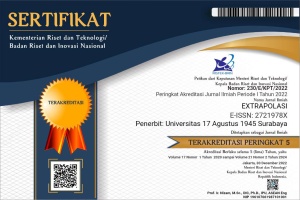ANALISIS ALTERNATIF DESAIN BANGUNAN JEMBATAN DENGAN VALUE ENGINEERING
Abstract
Planning or design phase of the bridge construction project is often not optimal, which affects the amount of waste and unnecessary costs of the construction phase of the bridge so that the application of Value Engineering efforts could be a solution to optimize the value of the benefits while reducing costs unnecessary. Besides, designs and models of various bridge today requires us to be able to choose a model which bridges the most suitable and appropriate to the local natural conditions. This study was conducted to determine the structure of the bridge what is the most economical but still complied with the required strength. The bridge was built with spans of 40 m and a width of 7 m is equipped with 2 (two) sidewalk on the right and left. In this study, the analysis will be conducted on three types of bridges, namely precast bridge, bridge and bridge betonkonvensional steel frame. The method used is a value engineering analysis of the four models that will bridge over the pre-cast bridge, bridge frame of steel and conventional concrete bridge. In the value engineering method (value engineering), there are several steps that must be done is the information phase, the analysis phase function, the creative stage and phase of development.  The results showed that of the three (3) alternative bridge is a conventional concrete bridge, precast concrete bridge, and the bridge framework. Obtained by a conventional concrete bridge structures bridge the most economical, while for bridge steel frame and precast concrete bridge as an alternative.
Keywords: Value Engineering, Bridge Building Structure, cost efficiency
Downloads
References
M. Ikhsan Sabri., 2011, Critical Succes Factor Penerapan Value Engineering Pada Tahap Konstruksi Bangunan Gedung pada PT. X, Program Pasca Sarjana, Universitas Indonesia, Jakarta.
Bima Sukma., 2011, Aplikasi Value Engineering dengan Metode “Paired Camparison†pada Struktur Pelat Beton Studi Kasus : Gedung “X†Empat Lantai, Fakultas Teknik Program Sarjana Universitas Indonesia, Jakarta.
Achmad Nurul Hidayat dan Denny Ardianto., 2011, Rekayasa Nilai Pembangunan Gedung Rusunawa Amabarawa (Value Engineering Construction of Ambarawa’s RUSUNAWA Building), Fakultas Teknik Sipil, Universitas Diponegoro.
Agung Basuki dan Herry Aguspriyana H, 2000, Aplikasi Analisis Nilai Pada Konstruksi Rangka Atap Gedung Kampus III Univesitas Janabadra Yogyakarta, Magister Teknik Sipil, Universitas Islam Indonesia, Yogyakarta
Hario Sabrang, 1998, Enjiniring Nilai, Diktat Kuliah, Program Pascasarjana, Program studi Magister Teknik, Universitas Atmajaya Yogyakarta.
Iman Soeharto., 1997, Manajemen Proyek, Dari Konseptual sampai dengan Operasional, Editor Yati Sumiati, Cetakan ke-2 Erlangga, Jakarta.
Iwan Agusdiansyah dan Hendri, 1999, Analisa Rekayasa Nilai Pada Struktur Atap Pembangunan Laboratorium Fakultas Teknik Industri Universitas Islam Indonesia, Yogyakarta, Magister Teknik Sipil, Universitas Islam Indonesia, Yogyakarta.
Adi Saptono., 2007, Analisis Penentuan Bangunan Atas Jembatan dengan Metode Rekayasa Nilai, Magister Teknik Sipil, Universitas Islam Indonesia, Yogyakarta.
Authors who publish with Extrapolasi agree to the following terms:
- Authors transfer the copyright and grant the journal right of first publication with the work simultaneously licensed under a Creative Commons Attribution-ShareAlike 4.0 International License.. that allows others to share the work with an acknowledgement of the work's authorship and initial publication in this journal.
- Authors are able to enter into separate, additional contractual arrangements for the non-exclusive distribution of the journal's published version of the work (e.g., post it to an institutional repository or publish it in a book), with an acknowledgement of its initial publication in this journal.
- Authors are permitted and encouraged to post their work online (e.g., in institutional repositories or on their website) prior to and during the submission process, as it can lead to productive exchanges, as well as earlier and greater citation of published work (See The Effect of Open Access)










